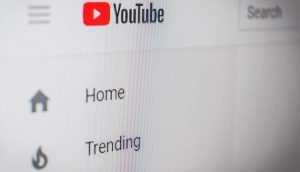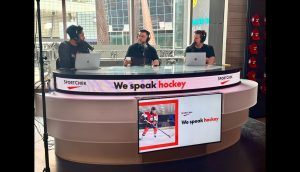If the speakers at the 2019 CBC Media Forum are to be believed, legacy media companies might want to take a few cues from the Marie Kondo phenomenon.
In the Netflix series Tidying Up With Marie Kondo, the world-renowned tidying expert shares her techniques for de-cluttering, including evaluating whether an item brings you joy and, when the time comes to get rid of something, to thank the item before bidding it farewell. Participants are asked not to simply purge everything mindlessly, but rather to hold onto what “sparks joy.”
What does that have to do with media? Everything, says transformation consultant and podcast host Aidan McCullen (pictured).
McCullen, speaking onstage at the pubcaster’s annual thought leadership event, believes media companies are holding onto things that might not bring them as much joy as they think. He referenced what’s commonly known as the “monkey trap” metaphor, in which monkeys will reach into hollowed-out coconuts for fruit and find themselves trapped, even to the point of captivity, simply because they refuse to let go of the fruit.
“We hang onto models of what we were, whatever status quo we had. We hold onto business models that no longer serve us.”
And, he says, if media companies aren’t changing on the inside at the rate that audiences are changing, then they’re in trouble. He already sees the pace as too slow. “We’ve just got the reins on digital, if even.” But, he added, the key to evolution is not to shed who you are entirely, but to incorporate key parts of your DNA into your future while quickly bidding adieu to the things dragging you down.
Here are the biggest takeaways from McCullen’s talk, as well from fellow speaker and Media Village founder Jack Myers
Media companies should value trust over speed
It’s easy to blame Facebook and other digital media platforms for the decline of many legacy media companies, but McCullen says it’s not so simple, as Facebook is not a direct competitor.
“People don’t often have relationships with Facebook. They’re just middlemen.” He compared it to when Netflix overtook Blockbuster drastically in the video market. “Blockbuster didn’t lose to Netflix, it lost to late fees,” he said.
But in the meantime, in the quest to adapt to the state of social media, win the news feed and be top-of-mind for all consumers, McCullen says brand identity, trust and even accuracy have taken a back seat. “Something like 20% of traffic comes through the front door – people going directly to the landing pages,” he said. Other people climb through the “side door” – usually searches and social referrals. While search and referral provide strong traffic, he says there’s rarely any loyalty associated.
“For media, there’s a huge opportunity to build trust, even if it’s slow.” While there’s no strategy to guarantee winning the news feed – people will click the link they see first because they see it first, not because it’s a brand they trust, he says – building better relationships with consumers through better, deeper stories and experiences will help increase the “front door” traffic of people coming to the landing page of their own free will.
He referred to programs such as iHeartRadio’s annual music awards and the New Yorker‘s annual festival as examples of media brands that have successfully built “offline” relationships with their audiences.
As for the speed of content, he says, it might behoove media to slow down slightly and take opportunities to dive deeper. “[People will say] you may miss the breaking story every now and then, but you’ve got the facts.”
Agencies need to reflect the population
Myers, a 40-year media veteran, says in the time he’s spent with various agencies, rep houses and media companies, he’s noticed that the workforce doesn’t reflect the demographics it’s trying to reach.
With most sales organizations still largely male and over the age of 35, he says, it’s losing out on diverse perspectives, regardless of how good the teams’ intentions are.
He has noticed some changes recently, including a large influx of young talent in agencies. “I think it’s very, very healthy that young people are increasingly moving into media buying,” he said, although he acknowledged that agencies are no longer able to hire at the rate they used to.
He also urged the audience to keep an eye on another vital group: autistic people. In the U.S., he said, consultancy Ernst and Young has stepped up its recruitment of people on the autism spectrum. “They’re much better at data and analytics,” he said, adding that there was significantly less training required in that area when working with people on the spectrum.
Myers says there’s another age demographic that’s often ignored in media plans. “My purchasing is [considered] irrelevant,” he said, referring to the fact that he is over 55. While reaching millennials is stressed in many campaigns, excluding those over 55 is a mistake. He even went as far to assert that this is what’s helping kill various forms of media, since people in that age group are most likely to consume media such as print and linear television.
Keep an eye out for what’s next
McCullen acknowledged that Amazon has become, under no uncertain terms, a new force to be reckoned with, and Myers agreed.
One major advantage it has is that it’s had a massive head start in the voice market, says McCullen. Citing ComScore’s stat that 50% of searches will be by voice in two years, he says Amazon’s media business will only continue to grow, with voice as a key driver.
But Myers added that now that the secret is out about Amazon’s advertising prowess, there’s another giant to watch out for: Walmart.
“Pay close attention to Vudu,” he told the audience, referring to a transactional VOD service owned by Walmart, which includes popular TV and movies. Walmart’s close relationship with vendors has played a major part in its acquisition of content. While Vudu is not yet available in Canada, Myers says he’s watching it closely as Walmart is reportedly “asking [its] vendors to support Vudu as an ad-supported platform.”
As for other VOD giants, Myers sees changes in Netflix’s future. While he doesn’t necessarily see commercial breaks embedded into streams, ads between content seem inevitable. “I expect Netflix to start accepting sponsorships that will take in about $1 billion per year.”
























